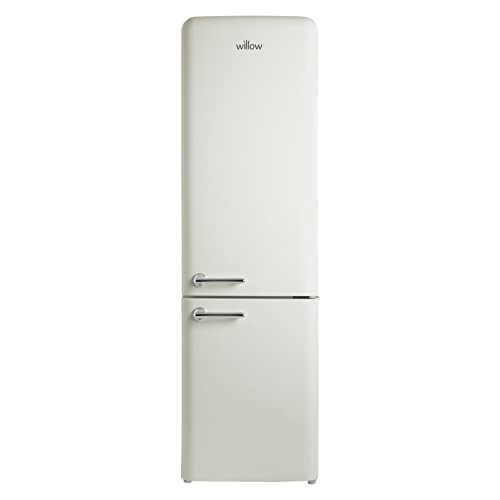Why Choose a Fridge Freezer Frost Free?
If you opt for a freezer fridge that is frost free, it will eliminate the need to defrost, saving you time and effort. They also have more storage than those that don't have this feature.
Place towels or old sheets close to the appliance to shield the area around the appliance from water drips.
There is no need to defrost.
Fridge Freezers that use Total No Frost technology circulate cool air continuously throughout each compartment. This prevents ice from ever forming on the freezer walls. This is an ideal solution for people who like to store a lot of things in the freezer but hate the idea of having to defrost it each year. If you have an accumulation of ice inside your freezer, it will normally undergo a defrost process automatically.
A freezer that is frost-free offers the obvious benefit of not having to defrost it, which is a lengthy and laborious process that can last up to 24 hours. A freezer that is frost-free can allow you to store more food since it doesn't require space.
Another benefit of a frost free freezer is that it has a higher energy efficiency than refrigerators that use conventional defrost systems, meaning you will save money on your electricity bills. Defrosting a refrigerator freezer is generally required when it contains an excessive amount of ice. The ice is preventing the refrigeration system from efficiently cooling the freezer.
It is usually caused by an unreliable thermostat that is not regulating temperature correctly. The freezer could have been shut and opened frequently, allowing moisture to get into the freezer. To avoid this ensure that food is cool before putting it in the fridge or freezer. Also, ensure the containers are sealed tightly.
By ensuring that your fridge is not overfilled it will decrease the likelihood of defrosting it. It is recommended to keep food in separate containers and use only small amounts at a time instead of filling the freezer to capacity. This will ensure that the freezer fan can move air around and is not blocked.
Make sure the door seal is not damaged. This is what keeps room air from getting into the freezer and fridge. If the seal is broken warm air could enter the fridge and cause frost to build up on the evaporator. To prevent this from happening, clean the evaporator coil with a specific spray, which can help in removing any frost that may have built up.
No more accumulation of ice
The absence of ice build-up implies that you'll need to defrost your freezer less often. If you notice frost on the back of your freezer it could be a sign your fridge-freezer is not functioning properly when it comes to defrosting. When a freezer or fridge is defrosting correctly, it will shut down its cooling system every six hours for 20 minutes so that the heaters can stop frost from developing behind the back wall and also on the evaporator. This allows air to flow freely between the freezer and the refrigerator to prevent food from freezing to the form of a hard consistency.
If your ice buildup is the result of hot air entering your freezer, you can minimize this by checking that the seal on the door is not broken or obstructed. Also, ensure that you're not overfilling your freezer or storing things in plastic bags or other containers that hinder cold air from moving around them. You should also make sure that your freezer is not located too close to a radiator or a heater.
In the event that you need to take out the accumulation of frozen ice from your freezer, it is recommended not to use a blade or other sharp instrument as this could damage the appliance. Unplug the appliance and let the ice melt. Clean the inside and plug it back in.
Alternatively, you can place an old towel on the floor in the freezer's front and wait for the ice to melt. Then, wipe down the freezer using a dry, clean cloth. Check that the temperature is in the right range prior to restocking.
If you're in the market for a new fridge freezer, think about one that has frost-free capabilities. It will cut down on time and effort. Contact best american fridge freezers for assistance or advice in choosing a new freezer. They'll help you find the perfect appliance for your lifestyle and budget. They'll also be able to provide support with your installation as well as any after-sales issues you might have.
No more smells

Unlike traditional fridge freezers where odors of bad smells can enter the freezer compartment and contaminate the food, frost free models are not a problem with this. The compressor circulates air to cool them. This air is at a temperature of around 0degC, so it doesn't produce smells. It is important to store food items in airtight containers, or wrap them in polyethylene baggies, plastic-coated freezer paper, heavy-duty foil or similar to reduce the amount of moisture that could escape from food items into the fridge.
Despite being frost free refrigerator freezers, they still need defrosting from time to time. They are not as efficient as conventional freezers. The evaporator coils are located in the back of the freezer and a defrost heater is used to melt the frost when it forms. If this isn't working, frost could build up on the evaporator and cause cooling problems.
If you don't have an automatic defrost device, you will have to manually defrost the freezer periodically. It takes only a few minutes and won't affect the taste of food. If, however, you have a Frost Free model with Total No Frost technology, it will never need to be defrosted because it continuously circulates cool air around each compartment, preventing accumulation of ice on the walls of the cabinet.
The odours inside a refrigerator freezer are caused by volatile chemical compounds, which react with water, while others aren't. If the smells are caused by microbial spoilage then the chemicals can move around and contaminate food items in the freezer. If the smells are not natural, they will remain in the refrigerator until they are released through the vent or are removed by the defrost cycle.
If odours start to enter the freezer, it's likely there's a problem with the seal or an issue with the cooling process. Moisture can get into the fridge freezer if the freezer door is left open, allowing warm, humid air to get in, or if the food packages are packed too tightly, restricting airflow.
Easy to clean
Refrigerator freezers that don't require manual defrosting are simpler to clean. When the freezer is empty, you can easily clean it using baking soda and water solution. Mix one tablespoon of baking powder with a quart warm water. Dip a microfiber towel into the solution and wipe all interior surfaces. You can also wipe down the seal around the door if it gets dirty. The cooling coils that are located at the back of the fridge are easier to clean because they don't have the ice. You should also not block the vents on the freezer, because they're in place to allow air to circulate. Crumbs, paper and twist ties could get caught into this area, and cause the fan to stop.
If your freezer smells like food that has been spoiled, you might require activated charcoal in an open container in the freezer for a couple of days to lessen or eliminate the smell. This kind of charcoal can be found at grocery stores in the section for cleaning.
Before you put your frozen food items back into the freezer It's an ideal idea to line the floor of the freezer with some old towels or cloths to ensure that melting ice doesn't soak up too much water. Be sure to clean your freezer's drawers, bins, and the ice tray prior to placing them back in the freezer.
The best way to avoid the need for a freezer defrost is to invest in refrigerators and freezers that have Total No Frost technology. This technology maintains the freezer compartment at even 0 degrees Fahrenheit and circulates cool air to prevent freezing on walls of the cabinet. This option will save you time and money in the long-term, as well as keep your food fresher for longer.
You should still defrost a conventional refrigerator at least once per year or when the ice layer is at least 1/4 inch thick. Also, make sure that the gasket on the door is sealing properly by closing the freezer on the back of a piece of paper. If it falls off easily the gasket must be replaced.
